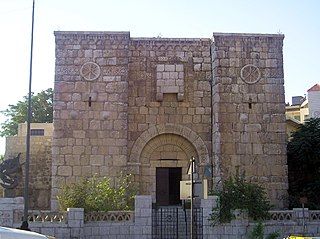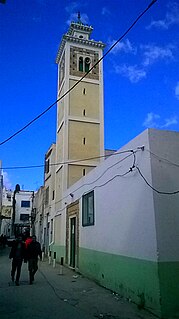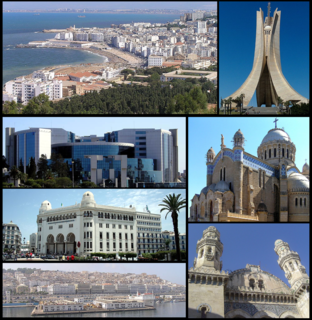
Bab Kisan is one of the seven ancient city-gates of Damascus, Syria. The gate, which is now located in the southeastern part of the Old City, was named in memory of a slave who became famous during a conquest by the Caliph Mu'awiya. The wall was built during the Roman era and was dedicated to Saturn. Bab Kisan was the escape route of St Paul.
Bab al-Hadid meaning the Iron Gate of Victory, is one of the nine historical gates of the Ancient City of Aleppo, Syria. It is one of the well-preserved gates of old Aleppo.

Bāb Antakiya formed one of the most important defense gates in Aleppo, protecting the city from the west. Baba Antakiya is located in the centre of the western wall of the old city of Aleppo, and its name was derived from Antioch, the capital of ancient Syria, as the gate was the main exit which was leading to the city of Antioch.

Bab Tuma is a borough of the Old City of Damascus in Syria, one of the seven gates inside the historical walls of the city, and a geographic landmark of Early Christianity. It owes its name to Saint Thomas the Apostle, one of the twelve apostles of Jesus Christ. During the Roman era, the gate was dedicated to Venus.

The Street Called Straight in the New Testament, or Damascus Straight Street is the Roman street which runs from east to west in the old city of Damascus, Syria. It was visited by Paul the Apostle as recorded in the Acts of the Apostles.

Bab al-Faraj or Bab al-Faradis was one of the 9 main gates of the ancient city walls of Aleppo, Syria. It was located at the northern side of the ancient city. The gate was ruined in 1904. Some remains are still found at the north-eastern part of the gate.

Bab al-Faraj also known as Bab al-Bawabijiyah and Bab al-Manakhiliyah is one of the gates of the old city of Damascus in Syria. The gate was built as part of a large program to re-fortify the city following its capture by Nur ad-Din Zangi in 1154. The twin gate crosses a bridge over a section of the Barada river that runs along the northern city walls of Damascus. The gate is notable for being the only surviving gate in the city that was built completely after the Muslim conquest of Damascus.

Bab al-Faradis or Bab al-Amara is one of the seven ancient city-gates of Damascus, Syria. One of the city's northern gates, it was named "the paradise gate" in the Roman age because it was surrounded by numerous water sources and gardens. The other name, Bab Al-Amara, refers to a name of a famous district in the old city where people in the 14th century would meet. During the Roman era, the gate was dedicated to Mercury.

Bab al-Jabiya is one of the seven ancient city-gates of Damascus, Syria. During the Roman era, the gate was dedicated to Mars. Bab al-Jabiya was the main entrance on the city's west side. The gate opens on Medhat Pasha Souq, which is the modern western half of the Street Called Straight, the Roman east-west artery (decumanus), which still connects it to Bab Sharqi. The gate's modern name dates to the Umayyad period and comes from the name of Jabiyah in the Golan Heights, then the capital city of the Ghassanids, allies of the Roman Empire.

Bab al-Salam is one of the seven ancient city-gates of Damascus, Syria. During the Roman era, it was also known as "Gate of the Moon".

Bab Sharqi, also known as the Gate of the Sun, is one of the seven ancient city gates of Damascus, Syria. Its modern name comes from its location in the eastern side of the city. The gate also gives its name to the Christian quarter surrounding it. The grand facade of the gate was reconstructed in the 1960s.

Icosium was a Punic and Berber city, a Roman colony, and an early medieval bishopric in the casbah area of Algiers..

Bab al Futuh is one of three remaining gates in the walls of the Old City of Cairo, Egypt. It was finished in the year 1087 and faces north. It stands at the northern end of Muizz Street. The other two remaining gates are Bab al-Nasr in the North and Bab Zuwayla in the south.

Bab al-Nasr meaning the Gate of Victory, is one of the nine historical gates of the Ancient City of Aleppo, Syria. It was partially ruined during the Ottoman rule over Syria.

The Gates of Homs refer to gates of the city of Homs in central Syria. Historically under the Abbasid dynasty, the city had seven gates. They were the following:
Bab al-Ahmar meaning the Red Gate, was one of the nine historical gates of the Ancient City of Aleppo, Syria. The name was derived from the village of al-Hamr as the gate was leading to the village at the eastern suburbs of ancient Aleppo.

Bab al-Faraj Clock Tower, is one of the main landmarks of Aleppo, Syria. It was built in 1898-1899 by the French architect of Aleppo city Charles Chartier with the help of the Syrian engineer Bakr Sidqi, under the Ottoman ruler of Aleppo; wāli Raif Pasha.

The Tronja Mosque is a Tunisian mosque, located in the Tronja area, which is a part of the Bab Souika suburb, in the north of the medina of Tunis.
Bab El Jazira or Bab Dzira, in English "gate of island", is one of the gates of the medina of Tunis.

Hammam Remimi Mosque is a tunisian mosque in the Halfaouine hood in the north of the Medina of Tunis.
















